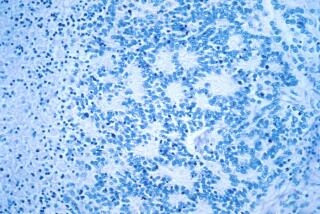Genes Used for 1st Time to Treat Cancer Patients : Medicine: Two people with melanoma receive special cells coded to produce powerful anti-tumor toxin.
- Share via
WASHINGTON — Researchers Tuesday began the first experiments using human gene therapy to treat cancer, the National Institutes of Health announced.
A 29-year-old woman and a 42-year-old man with advanced melanoma, a potentially lethal form of skin cancer, received transfusions of special cancer-killing cells removed from their own tumors, along with a gene that has been coded to produce a powerful anti-tumor toxin. The hope is that the mixture will destroy the patients’ cancers.
“We’re desperately trying to open a new door for cancer treatment, and this is just the first small step,” said Dr. Steven A. Rosenberg, chief of surgery at the National Cancer Institute and the lead researcher on the project. This is the second attempt at human gene therapy but the first aimed at treating cancer, a disease that afflicts millions of people.
However, he noted that, if the experiment works, it will be a major breakthrough.
“If we can get it to work with melanoma, these kinds of approaches will be applicable to patients with a lot of different kinds of cancers,” he added. “I hope it helps these patients. But, even if it doesn’t, I’m optimistic that eventually we can use the tool of gene therapy to develop better cancer treatments.”
Researchers believe that the results of the treatment will be known within months.
Melanoma will strike an estimated 32,000 people this year and is expected to kill about 6,500. Moreover, its frequency has been increasing at the rate of about 4% a year, according to the American Cancer Society.
If detected very early, melanoma can be cured by surgery. Advanced melanoma, however, does not respond to any known treatment. Most patients in this stage usually die within about four months.
“It is very exciting to see gene therapy finally beginning to be used in the management and research of patients with cancer,” said Dr. John Laszlo, senior vice president for research of the American Cancer Society.
Rosenberg said that the Food and Drug Administration had given the National Institutes of Health permission to perform the experimental treatment on up to 50 melanoma patients this year.
The human body is made up of about 50 trillion cells. Genes direct each cell’s function. When a gene is destroyed or broken, the cell’s function is disrupted or eliminated--and disease occurs.
There are two basic approaches to human gene therapy. Scientists can introduce a normal gene in an attempt to correct a defective gene or replace a missing one. Alternatively, the genes can be used to enhance a cell’s function or to give it a new one.
Rosenberg and his colleagues have attempted to design a kind of super-cell by adding a new gene to the patient’s own cancer-fighting cells, called tumor infiltrating lymphocytes. The new gene has been coded to stimulate the production of tumor necrosis factor, a potent hormone that kills tumors by cutting off their blood supply.
Tumor necrosis factor has shown dramatic effect on tumors in mice but thus far has had no effect on cancer when injected into humans. This is probably because humans cannot be treated with the hormone level given to mice, which can tolerate 40 times as much tumor necrosis factor as humans. The hormone is naturally produced by the body to fight bacterial infections but, if it is active for too long or at too high a level, it can cause shock and body wasting.
But, because the tumor infiltrating lymphocytes zero in only on the tumors, scientists hope that they can deliver the cells directly to the cancer to function as “factories,” producing tumor necrosis factor directly where it is needed--and in doses high enough to kill the cancer but not high enough to harm the patient.
Since 1986, Rosenberg has been treating melanoma with tumor infiltrating lymphocytes that have not been gene-altered and has seen improvement in about 40% of his patients. Rosenberg said that he hopes the gene-modified cells will “enhance the ability of (tumor infiltrating lymphocytes) to destroy tumor cells.”
Gene technology has been used in humans on two previous occasions.
On Sept. 14, the National Institutes of Health performed the first human gene therapy experiment. A 4-year-old girl with adenosine deaminase deficiency, an inherited immune system disorder, was transfused with her own white blood cells that had been altered in the laboratory by adding the human gene that stimulates production of adenosine deaminase. The enzyme is crucial to the proper functioning of the immune system.
Adenosine deaminase deficiency afflicts only about 30 children worldwide. Researchers will not know for about a year what effect the treatment is having on the girl.
Earlier, Rosenberg inserted gene-altered cells into melanoma patients, but the genes had no therapeutic function. They were used only as “markers” to identify cancer-fighting cells.






